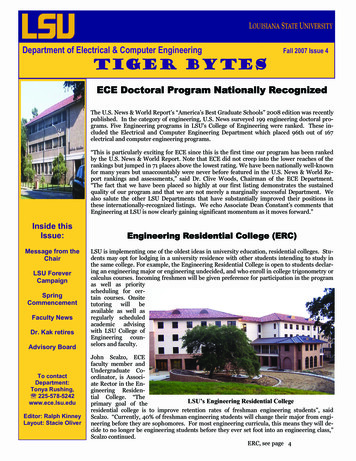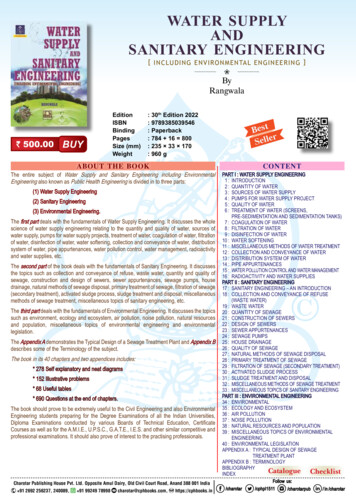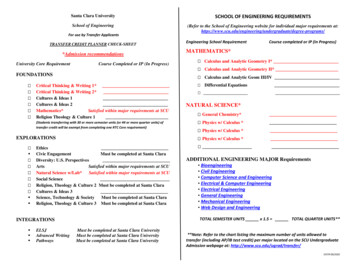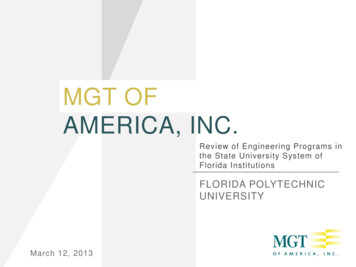
Transcription
Program Overview - Computer EngineeringYear IHours/weekSemester INo.M/ECoursesLNELabECTSTeacher1.MAdvanced Algorithms2206Agni Dika2.MProgramming Paradigms2206Idriz Ismajli3.MAdvanced Computer Logic Design2206Astrit Ademaj4.MInformation Security2206Blerim Rexha5.MArtificial Intelligence2206Nysret MusliuSemester II1.MSemantic Web2206Lule Ahmedi2.MDistributed Programming2206Isak Shabani3.MSystems Programming2206Idriz Ismajli4.MLegal, Ethical and Social Issues inICT2206Blerim Rexha5.EElective Courses:1. Methodology of scientificresearch2. Computer Vision (ImageUnderstanding)22061. Lule Ahmedi22062. Yll HaxhimusaIn the IInd year of studies, students can choose from two group of courses in the area of Databases or NetworkSecurityDatabases and artificial intelligenceYear IIHours/weekSemester IIINo.M/ECoursesL1.MWeb Services2105Isak Shabani2.Me-Governance2105Blerim Rexha3.MNature Inspired Algorithms2105Agn i Dika4MSeminar in information systems2105Lule Ahmedi5MStrategic Management2105Bernard Nikaj6EElective courses:1. Patter Recognition2105andNELabECTSTeacher1. Yll Haxhimusa
Machine Learning2. Parallel Programming3. Hardware Programming4. Cloud computing2221010105552. Blerim Rexha3. Agni Dika4. Astrit AdemajComputer Network SecuritySemester IIIHours/weekNo.M/ECoursesLNELabECTS1MPatter Recognition and MachineLearning2105Yll Haxhimusa2MParallel Programming2105Blerim Rexha3MHardware Programming2105Agni Dika4MCloud computing2105Astrit Ademaj5MStrategic Management2105Bernard Nikaj6EElective courses:1. Web Services2. e-Governance3. NatureInspiredAlgorithms4. Seminar in informationsystems2221110005551. Isak Shabani2. Blerim Rexha3. Agni Dika21054. Lule AhmediSemester IVMaster thesisTeacher30
1.1.1. Course DescriptionsCourse title: Advanced Algorithms (Mandatory, Sem I, 6 ECTS)The goal: Course provides advanced knowledge about major algorithms and data structures techniquesLearning outcomes: On successful completion of the course, students will be able to:1. Use advanced sorting techniques; 2. Use graph algorithms, 3.Use hashing techniques, 4. Use linkedlists; 5. Know algorithms about pattern matching; 6. Use techniques from linear programming; 7. Usetechniques from dynamic programming; 8. Apply combinatorial Search methods.Course content: Review of sorting algorithms. Review of graph algorithms. Hashing techniques. Linkedlists. Pattern Matching. Linear programming. Dynamic programming. Combinatorial Search.Methods of teaching: 30 hours of lectures 30 hours of laboratory exercises. Approximately 100 hoursof personal study and exercise including homework.Grading System: Attendance 10%, Mid-term exams 30 %, Final Exam 60 %Literature:1. R. Sedgewick (2001). Algorithms in C: F undamentals, Data Structures, Sorting, Searchingand Graph Algorithms in C, Addison Wesley2. Adam Drozdek (2000). Data Structures and Algorithms in C , Course TechnologyLatest3. Jeffrey J. McConnell (2001), Analysis of Algorithms: An Active Learning Approach, Jonesand Bartlett PublishersCourse title: Programming Paradigms (Mandatory, Sem. I, 6 ECTS)The goal: The objective of this course is to provide the students the advanced programming techniques.The well-designed, well-decomposed, factorized and easy-to-understand code based on the atomicapproach will be the focus of this course. This means that not only the object-oriented programmingparadigm but also the advantages of applying this paradigm in procedural programming will be handledin this course.Learning outcomes: On completion of this course, students shall be able to: (1) apply the atomicapproach, (2) to achieve a well open-designed system, (3) to reach a high cohesion and low-coupling, (4)to achieve a well-designed and reusable software components.Course content: This course among others will contain: (1) software programming paradigm, (2) objectoriented programming paradigm, (3) cohesion, 4) coupling, (5) factorization, (6) open design.Methods of teaching: 30 hours of lectures 20 hours of tutorials exercises 10 hours of laboratoryexercises. Approximately 100 hours of personal study and exercise including appointments.Grading System: Classroom Assessment 0%, Appointments 15%, Project 20%, Final assessment 65%Literature:1. Stanley Lippman, Essential C , ISBN-10 0201485184, 19992. R. Kent Dybvig, The SchemeProgrammingLanguageBeginning Linux Programming, 4th Edition,ISBN 0-262-62077-4, 19903. David R. Musser, Gillmer J. Derge, Atul Saini, STLTutorialandReferenceGuide,ISBN 9780201379235, 1995Course title (the subject): Advanced Computer Logic Design (Mandatory, Sem I, 6 ECTS)The aim of the course (module): Through this course students will learn the procedures used in thedesign of complex digital circuits, including the design and practical implementation of 4-bitmicroprocessor that is able to execute 16 different instructions.Learning outcomes: After completing this course the student should be able to: 1. To synthesize thebasic digital circuits, such as various arithmetic circuits. 2. To analyze synchronous sequential and
asynchronous sequential circuits, using tables and diagrams of the situation and finally the presentation oftheir work through the situation diagrams. 3. Synthesize different sequential circuits, described by thesituation tables or situation diagrams. 4. To test synthesized circuits using one of the simulation programs,such as Multisim.5. To design multi-bit circuits that are able to execute a number of basic instructions.Contents: Basic knowledge on combinatorial and sequential digital circuits. Design and practicalimplementation of complex digital circuits. Multi-bit arithmetic circuits for performing basic arithmeticoperations. Circuits for adding encoded numbers in NBCD and Excess-3 code. Synthesis of varioussequential circuits: detectors of binary sequences, increasing/decreasing counters, counters until a certaincondition, registers etc. Internal organization of digital memory. Synthesis of complex digital circuits withmany inputs and outputs. Synthesis and practical realization of the digital clock. Synthesis of 4-bitmicroprocessor which is able to execute 16 basic operations.Methodology of teaching 30 hours of lectures and 30 hours of laboratory exercises. Approximately 60hours of independent work including work on independent projects.Evaluation:Attendance 10%, Project Evaluation 30%, Final Exam 60%Literature:1. M. Morris Mano. Computer Logic Design. Prentice-Hall, Englewood Cliffs, New Jersey.2. H. Troy Nagle, Jr., B. D. Carroli, J. D. Irwin. An introduction to Computer Logic. PrenticeHall, Englewood Cliffs, New Jersey.3. George K. Kostopoulos. Digital Engineering. John Wiley & Sons, New York.Course title: Information Security (Mandatory, Sem. I, 6 ECTS)Qëllimi i kursit (modulit):. This course provides a broad view of information assurance and securityconcepts, to appreciate the importance of information security , protection of information assets; access toinformation system; legislation and industrial standards.Learning outcomes: This course will prepare students to: (1) Information, Information Systems andManagement Information Systems, (2) Identify threats to a computer network: intrusion, Denial ofService, attacks, and malware. (3) Information Security challenges brought about by computers and theInternet. (4) Importance of protecting information assets. (5) Information Security terminology andcryptographic algorthms. (6) Database and database security. (7) Software Security.Course content: Information, Information Systems and Management Information Systems; InformationSecurity awareness:Training, Education, Profession opportunities; Basic Information Securityterminology: Confidentiality, Integrity, Availability, Authentication and Authorization, Configuration andcontrol, Auditing, Policies, Risk Management; Database and database security: data mart and datamining; Information Security Countermeasures: Procedures, Industrial Practices, Physical Access,Alarmsand Reporting Structures, Servers Room Protection, Organizational Roles; SoftwareSecurity:Configuration, Version Control, Documentation, Sandbox, Validation, Testing; VariousLegislationsMethods of teaching: 30 hours of lectures 10 hours of practical exercises 5 hours of laboratoryexercises. Approximately 100 hours of personal study and exercise including seminars.Grading System: Seminar 10%, Midterm exams 30 %, Final Exam 60 %Literature:1. Conklin et al, Principlesof Computer Security: Security and Beyond, 1st Edition McGrawHill, 20052. Merkow, M, Breithaupt, J, Information Security: Principles and Practices Prentice HallISBN: 0-13-154729-1, 20063. Cryptography and Network Security, by William Stallings, ISBN 0-13-187316-4, publishedby Prentice Hall, 2006.
Course title: Artificial Intelligence (Mandatory, Sem. I, 6 ECTS)The goal: The objective of this course is to give a broad introduction to core concepts of artificialintelligence, including problem solving and search, constraint satisfaction problems and techniques,(meta)heuristic algorithms, and machine learning techniques.Learning outcomes: A student completing this course should: be able to explain and use exact problemsolving techniques in artificial intelligence; understand (met)heuristic techniques and be able to applythem for solving different problems;understand concepts of machine learning and be able to explainsupervised machine learning techniques; be able to apply supervised machine learning techniques in reallife applications; be able to implement small intelligent systems, which are based on artificial intelligencetechniquesCourse content: Topics include: intelligent agents, problem solving and search, constraint satisfactionproblems and constraint programming techniques, (meta)heuristic techniques, adversarial search andgame playing, machine learning concepts, and supervised machine learning techniques.Methods of teaching: Lectures, labs, demonstration of artificial intelligence applications,assignments/projects.Grading System:Mid-term exam (20%), Final exam (40%), Assignments/Projects (40%)Literature:1. Artificial Intelligence: A Modern Approach (Third Edition) by Stuart Russell and Peter Norvig;20092. Z. Michalewicz and D. B. Fogel. How to Solve It: Modern Heuristics, 2nd edition, SpringerVerlag, 2004Course title: Semantic Web (Mandatory, Sem. II, 6 ECTS)The goal:The Internet is on the verge to make the vision of the Semantic Web a reality. In Semantic Web,almost every single resource ever including people (their profiles) is anchored to the Web, and madeexplicit and understandable not only by humans but also by machines. This new Web thus ensures quick,accurate and enhanced web search among others when compared to the traditional Web. In this course,we will examine this exciting area by developing diverse semantic-aware applications.Learning outcomes: Upon completion of this course, students should be able to: 1. Demonstrate theirfamiliarity with different paradigms of modeling and manipulating data with less semantics to those withsemantics as to be understood by computing machines. 2. Apply concepts and technologies of SemanticWeb to develop non-traditional applications which infer new knowledge out of already known data /knowledge.Course content: Topics to cover include: Simple ontologies in RDF and RDF Schema; OWL ontologies;The extension of OWL: OWL 2; Queries on Semantic Web: SPARQL; Rules in Semantic Web: SWRLand RIF; Identifiers and hyper-links in Semantic Web; Exporting databases, XML, etc. into RDF/RDFSchema/ontologies; Linked Data; Beyond fundamentals: applications.Methods of teaching: 30 hours of lectures 15 hours of auditorial exercises 15 hours of laboratoryexercises. Approximately 100 hours of personal study and exercise including project work.Grading System: Project assignment 3 x 20% 60%, Final Exam 40 %Literature:1. Foundations of Semantic Web Technologies. P. Hitzler, S. Rudolph and M. Krötzsch. Chapman& Hall, 2009.2. Semantic Web Programming. John Hebeler, Matthew Fisher, Ryan Blace, Andrew Perez-Lopez,Mike Dean. Wiley, 2009.3. A Semantic Web Primer (2nd edition). Grigoris Antoniou, Frank van Harmelen. The MIT Press,2008.
Course title: Distributed Programming (Mandatory, Sem II. 6 ECTS).The goal: The course aim is to prepare students to understand distributed programming techniques andapply them in practice.Learning outcomes: On successful completion of the course, students will be able to: 1. To understanddistributed algorithms; 2. To create distributed objects and methods; 3. To create and develop distributedapplications; 4.To manage with distributed applications; 5. Realize e project relating a particular issuewith distributed applications.Course content: Introduction to distributed programming. Fundamentals algorithms and terminology.Distributed Algorithms. Remote Objects Technology. RPC. RMI. CORBA. .NET Remoting. DistributedCalculation Methods. Logical Time. Global state and snapshot recording algorithms. Message Queuingand group communications. Termination detections. Mutually exclusive distributed algorithms. Deadlockdetection. Shared Distributed Memory.Methods of teaching: 30 hours of lecture, 30 hours of auditoria exercises and laboratory exercises.Approximately 100 hours of personal study and exercise including project.Grading System: Attendance 10%, Project 30 %, written tests or final exam 60%.Literature:1. Ajay D. Kshemkalyani, MukeshSinghal, “Distributed Computing Principles, Algorithms, andSystems, Cambridge University Press, 2008.2. George Coulouris, Jean Dollimore, Tim Kindberg, Peter Baer Galvin dhe Greg Gagne ,“Distributed Systems – Concepts and Design”, 5th Edition, 2012.3. Sarah Morgan, Bill Ryan, Shannon Horn, Mark Blomsma, Murray Gordon, Scott Allen, “.NETFramework 2.0 distributed Application Development”, 2006.Course title: Systems Programming (Mandatory, Sem. II, 6 ECTS)The goal: The objective of this course is to provide the students with the basic knowledge needed forsystem programming. The issues addressed in this course are: thread/process manipulating, system i/o(input/output), memory management, file system, signals, mutexes, semaphores, pipes, sockets, etc. Thedevelopment platform will be Linux (Debian) and Unix (open source Solaris), but Windows will be alsoused during the course.Learning outcomes: On completion of this course, students shall: (1) Have basic knowledge aboutsystem programming, (2) have knowledge manipulating with threads/processes (3) be able to implementan inter-task (thread/process) synchronization or communication, (4) to manipulate with files anddirectories, and (5) to use sockets for network communication.Course content: This course among others will contain: (1) Concept of Task (Process/Thread), (2)Deadline, (3) Mutual Exclusion, 4) Semaphores, (5) Mutexes, (6) Sockets, (7) Concurrent Programming,(8) Inter-Task (Process/Thread) Communication and Synchronisation.Methods of teaching: 30 hours of lectures 20 hours of tutorials exercises 10 hours of laboratoryexercises. Approximately 100 hours of personal study and exercise including appointments.Grading System: Classroom Assessment 0%, Appointments 15%, Project 20%, Final assessment 65%Literature:1. Michael Kerrisk, The Linux Programming Interface – A Linux and Unix System ProgrammingHandbook, ISBN-10 1-59327-220-0, 20102. Neil Matthew, Richard Stones, Beginning Linux Programming, 4th Edition, ISBN 978-0-47014762-7, 20083. Kay A. Robbins, Stephen Robbins, Unix Systems Programming – Communication, Concurrencyand Threads, ISBN 0-13-042411-0, 2003
Course title: Legal, Ethical and Social Issues in ICT (Mandatory, Sem.II, 6 ECTS)The goal: The purpose of the course is to motivate and apply the concept of critical thinking andinformation technology’s impact on personal, societal, legal and ethical issues.Learning outcomes: On successful completion of the course, students will be able to:Think critically about information technology issues, actively engage others in dialogue about them, andrelate them to personal and societal values. Analyzing and critically evaluate ideas, arguments, and pointsof view. Express a reasoned position on an issue, both orally and in writing. Analyze the relationshipsamong ethical, social, and political issues that are raised by information systems. Identify the main moraldimensions of an information society and specific principles for conduct that can be used to guide ethicaldecisions.Course content: Introduction to Ethical Theory; Professional Ethics and Responsibility; CriticalThinking Skills; Technology and Privacy; Technology and Free Speech; Encryption and Communication;Intellectual Property; Cybernetic Crime, Security and Protection; Moral Dimension of InformationSystem; Social Issues and Technology;Methods of teaching: 30 hours of lectures 15 hours of auditorial exercises 15 hours of laboratoryexercises. Approximately 90 hours of personal study and exercise including seminars.Grading System: Seminar 10%, Mid-term exams 30 %, Final Exam 60 %Literature:1. Sara Baase, Gift of Fire, A: Social, Legal, and Ethical Issues for Computing Technology, 4/E,ISBN-10: 01324926792. Joseph Migga Kizza, Ethical and Social Issues in the Information Age, fourth edition, ISBN 9781-84996-037-33. M. David Ermann, Michele S. Shauf; Computers, Ethics, and Society latest Edition, OxfordUniversity Press, ISBN: 0195143027Course title: Methodology of scientific research (Elective, Sem II, 6 ECTS)Course objectives: To introduce some key elements of research methodology to first time researchstudents.Learning outcomes: At the end of this course, the students should be able to: understand some basicconcepts of research and its methodologies, identify appropriate research topics, select and defineappropriate research problem and parameters, prepare a project proposal (to undertake a project), organizeand conduct research (advanced project) in a more appropriate manner, write a research report and thesis,write a research proposal (grants).Course content: Overview of experimental and engineering methodological approaches to research;Basics of research design (e.g., hypothesis formulation); The research process: documenting research,sources of information, research funding, creativity and intellectual discovery; Guidelines and aframework for efficient development of research; legal and ethical issues; protecting and exploitingresearch; Intellectual Property rights; Managing the research project: supervision, planning andorganization; problems and pitfalls; Presentation skills (written, oral); Use of relevant research tools(technology, experimental infrastructure, mathematical methods, etc.).Teaching methodology: 30 hours of lectures 30 hours of supervised exercises. Approximately 75 hoursof personal study, including homework exercises.Grading System: Homework 10%, Mid-term exams 30 %, Final Exam 60 %Literature:1. Kothari B.L., “Research Methodology: Tools and Techniques”, New Age InternationalPublishers, 2009.2. Boot C. W., “The Craft of Research”, University Of Chicago Press, 2008.
Course title: Computer Vision (Image Understanding) (Elective,Sem II, 6 ECTS)The goal:The goal is to provide the students with the basic knowledge of digital image processing,computer vision and image understanding so that they will be able to work extract information fromimages and videos and understand the relevant scientific literature. The lecture provides a set of methodsand algorithms, which can be applied and tested on real imagery in the practical course.Learning outcomes: On completion of this course, students will (1) understand the core technologies inimage processing and computer vision, (2) process information out of images and videos, (2) archive andretrieve images, (4) compress images, (5) do image analysis for application like industrial inspection,robotics and similar applications. (7)The students will be able to read and understand the state-of-the-artliterature and work in teams.Course content: Image analysis techniques from image acquisition to complex scene interpretation,including: human visual system, image formation, image preprocessing, mathematical morphology, imagesegmentation, color image analysis, texture analysis, object recognition, data structures for imageanalysis, radiometric and geometric transformations, image data compression, 3d image processing, andscene understanding.Methods of teaching: 30 hours of lectures 30 hours of tutorials exercises. 90 hours of personal studyand home exercises (5 * 30 h 150 h).Grading System: Classroom Assessment 5%, Home works and projects 35%, Final assessment 60 %Literature:1. R. Szeliski. Computer Vision, Springer 2011.2. M. Sonka, V. Hlavac, R. Boyle: Image Processing, Analysis and Machine Vision (2nd Edition),PWS Publishing, 1999P.3. State-of-the-art papers“Databases and artificial intelligence”Course title: Web Services (Mandatory, Sem III, 5 ECTS).The goal: Course aim is to provide students with concepts and techniques on Web services with a fullcoverage on the development and usage of Web services.Learning outcomes: On successful completion of the course, students will be able to:1.To understand main concepts, web services model and architecture; 2. To compare and make distinctionamong Web services; 3.To allow computer applications to communicate with other applications in othercomputers through web services on the internet; 4. To write code and create web methods; 5. Toimplement a project on related issues using Web services .Course content: What are Web services. Web services model and architecture. XML and XML Schema.XML serialization. XML Web services. SOAP protocol. WSDL. UDDI register. Web servicesdevelopment with Java and C#.NET. Client-Server Web Services. Web Services Programming module.Web service composition. Web service merging. Security Web services, Web service standards:BPEL4WS, WS-Policy, etc.Methods of teaching: 30 hours of lecture, 30 hours of auditoria exercises and laboratory exercises.Approximately 100 hours of personal study and exercise including project.Grading System: Attendance 10%, Project 30 %, written tests or final exam 60%.Literature:1. Eric Newcomer, “Understanding Web Services: XML, WSDL, SOAP, and UDDI”, 2005.
2. Sandeep Chatterjee and James Webber, "Developing Enterprise Web Services", PearsonEducation, 2004.3. McGovern, et al., "Java Web Services Architecture", Morgan Kaufmann Publishers, 2005.Course title: e-Governance (Mandatory, Sem III. 5 ECTS)The goal: Introducing theelectronic governance concepts, Interoperability, design and architecture of thecommunication system over the Internet, Fundamentals of the public administration, process modelingand legal infrastructure.Learning outcomes:After completing this course (course) the student will be able: (1) explainfundamentals of electronic governance, gain a policy and organizational perspective on InformationTechnology and its relationship to strategic planning, (2) gain a basic understanding of new technologiesincluding the Internet, Intranets, Extranets, and Electronic Commerce and how they impact governmentoperations and structure, (3) study the changing models of government service delivery, (4) Criticallyevaluate e-government projects, (5) Identify ethical dimensions of information policy.Course content: Information technology and administrative reform, Governance in a connected world,Strategic planning and e-Government, How IT can Improve the Efficiency and Effectiveness ofGovernment Organizations, information security and privacy , democracy online, managing digitalidentity, System integration and organizational barriers.Methods of teaching:30 hours for lectures, 15 hours for exercises and approximately 90 hours ofindependent work including seminar paper.Grading System:Attendance and classroom activity: 10%, intermediate evaluations 30%, final exam60%Literature:1. Fountain, J. E. (2001). Building the virtual state : information technology andinstitutional change. Washington, D.C.: Brookings Institution Press. ISBN: 08157007842. Rosen, J., & Wittes, B. (2012). Constitution 3.0 : freedom and technological change.Washington, D.C.: Brookings Institution Press. ISBN: 97808157221203. Mayer-Schèonberger, V., & Lazer., D. (2007). Governance and information technology :from electronic government to information government. Cambridge, Mass.: MIT Press.4. Pavlichev, A., & Garson, G. D. (2004). Digital government : principles and bestpractices. Hershey, PA: Idea Group Pub. ISBN: 1591401224Course title: Nature Inspired Algorithms (Mandatory, Sem. III, 5 ECTS)The goal: Course provides in depth knowledge about major algorithms that are inspired from natureLearning outcomes: On successful completion of the course, students will be able to: 1. Model variouscomplex optimisation problems; 2. Use techniques from evolutionary algorithms, 3.Use techniques fromswarm algorithms, 4. Use techniques from physical algorithms; 5. Hybridize the previous techniques; 6.Perform systematic tests of the presented techniques.Course content: Evolutionary algorithms (Genetic algorithms); Swarm Algorithms (Bees Algorithm, AntColony Optimization); Physical Algorithms (Extremal Optimization, Harmony Search, CulturalAlgorithm, Memetic Algorithm); Hybridization of different approaches presented above.Methods of teaching: 30 hours of lectures 15 hours of laboratory exercises. Approximately 90 hours ofpersonal study and exercise including homework.Grading System: Attendance 10%, Mid-term exams 30 %, Final Exam 60 %Literature:1. Brownlee, Jason, Clever Algorithms: Nature Inspired Programming Recipes, First Edition.LuLu. January 2011, ISBN: 978-1-4467-8506-5
2. Michalewicz, Z., and Fogel, D. B., How to Solve It: Modern Heuristics, Springer, 19953. Latest related papers that utilize the presented optimization techniques.Course title: Seminar in information systems (Mandatory, Sem. III, 5 ECTS)The goal:To offer the students the opportunity to explore an actual research topic in the field ofinformation systems under the guidance and supervision of the instructor, and discuss it and a range ofrelated topics within the seminar.Learning outcomes: Upon completion of this course, students will be able to: 1. Elaborate researchquestions of the corresponding field by using the up-to-date literature. 2. Acquire knowledge on selectedrange of actual research topics. 3. Gain experience on the presentation techniques and on how to write areport.Course content: Topics will be covered to provide an in-depth knowledge of the given special sub- fieldof information systems.The instructor provides seminar topics on the field of information systems depending on his/her currentresearch interests, and conform to the trends in that field. These topics would usually envision the thesissubjects from the field of information systems to be offered in the fourth semester. Topics vary fromsemester to semester. Enrollment limits are set by the instructor, as well as the pre-requisites set atdiscretion of instructor.Methods of teaching: The course consists of: the kick-off meeting with students interested for the field atthe beginning of the semester and distribution of each one topic per student, provide students with theliterature required, supervision of the students throughout the whole semester, student presentationsessions at the end of the semester, and deliverable of the written reports which shall summarize thestudent’s work on the topic he/she elaborated.Grading System: Presentation 30%, Research report 25%, Software 25% (if no software developed aspart of the seminar, points considered in the research report), Active participation 20%.Literature:1. A comprehensive list of actual resources, i.e., book chapters, research papers, and/or Webresources on each topic of the seminar.2. A list of tools/systems to support the development of the seminar work.Subject Title : Strategic Management (Mandatory, Sem III, 6 ECTS)Course/Module aim: This module aims to introduce to students the concepts of strategy and itsimportance in managing organizations. It also aims to provide students with enough possibilities to seeand apply concepts in practice.Expected outcomes : This course is an introduction to the field of Strategic Management. It covers thekey concepts and theories in the field and how they can be applied to real business situations. All topicsare illustrated with case studies about real companies in various different industries. Both lectures andclasses will be organized around business cases; in the classes, students are expected to makepresentations and to participate actively in the discussions.Course contents: Topics include: Sources of competitive advantage; Strategic positioning andcompetition, Building capabilities: Incentives and coordination; Firm scope, vertical integration, andoutsourcing; Entrepreneurial firms; Thinking strategically: Competition, strategic investments, and realoptions; Strategy for Information Markets / Network effects; Corporate strategy; Mergers andacquisitions.Teaching methodology:30 hours of lectures, 30 hours of practice. Approximately 100 hours ofindependent work, including the case study preparation. During practice an important role is played by
guest lecturers who are usually sucessfull kosovar entreprenuers talking about their approach to strategyand the importance of strategic management in their organization.Grading: Case Study on strategy identification 40%, Final Exam 60 % .Literature :1. Saloner, G., Shepard, A., and Poldony, J., Strategic Management. John Wiley & Sons. (2001;revised version 2005)Course title: Patter Recognition and Machine Learning (Elective,Sem III,5 ECTS)The goal: The aim of the lecture is to present the basic concepts and techniques of pattern recognitionmachine learning as well as their application for e.g. in medicine.Learning outcomes: Student will be able to analyze practical problems, and offer a solution to theprobl
1. Conklin et al, Principlesof Computer Security: Security and Beyond, 1st Edition McGraw Hill, 2005 2. Merkow, M, Breithaupt, J, Information Security: Principles and Practices Prentice Hall ISBN: -13-154729-1, 2006 3. Cryptography and Network Security, by William Stallings, ISBN 0-13-187316-4, published by Prentice Hall, 2006.











